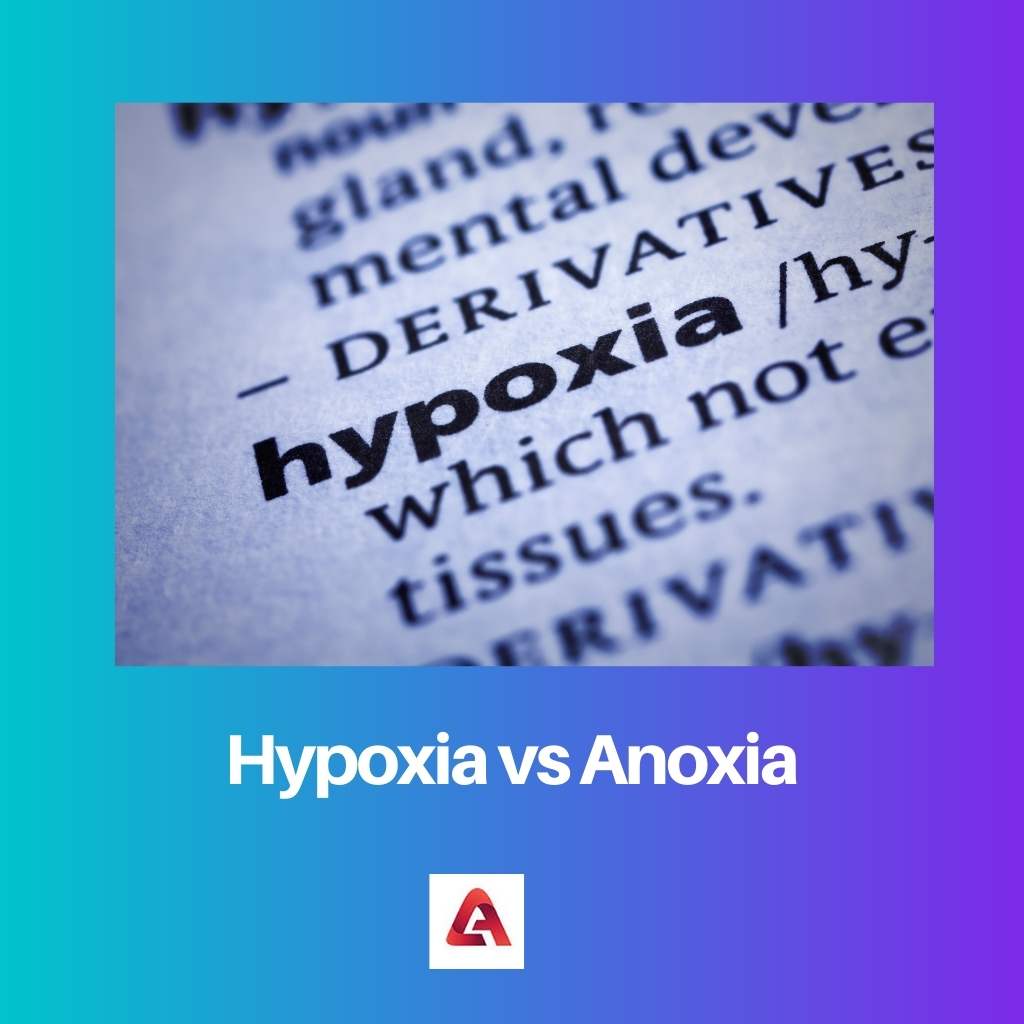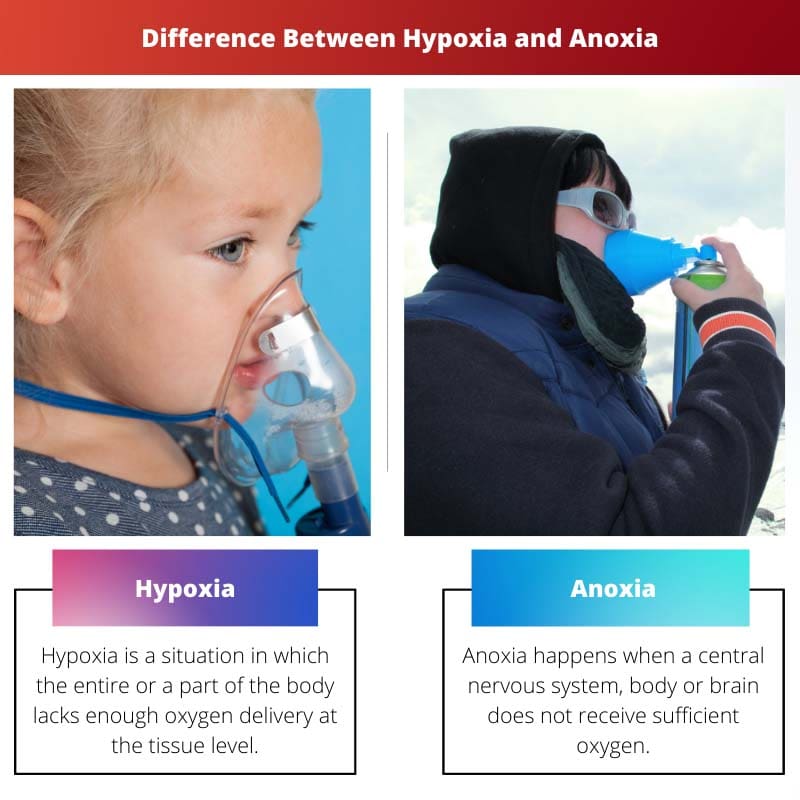Anoxia and hypoxia are indeed grave, life-threatening disorders caused by a lack of oxygen in the body.
The phrases anoxia versus hypoxia are sometimes used indiscriminately, yet there are distinctions between both of them, and hence using them interchangeably is not right.
Even if they both describe circumstances in which systems and tissues, such as the brain, get little oxygen, understanding the distinction between both terminology is critical.
So, this article is here to help you understand the differences between both terms.
Key Takeaways
- Hypoxia is when the body or a specific region experiences a deficiency in oxygen supply, leading to impaired cellular function.
- Anoxia is a more severe form of oxygen deprivation, where the absence of oxygen can cause rapid and extensive tissue damage.
- Both conditions can result from various causes, including respiratory disorders, circulatory problems, and environmental factors.
Hypoxia vs Anoxia
Hypoxia refers to a condition where there is a decreased oxygen supply to the body’s tissues, caused by a variety of factors, including lung diseases, heart diseases, and anaemia. Anoxia is a more severe condition that occurs when there is a complete lack of oxygen supply to the body’s tissues.

Hypoxia is a situation in which the entire or a part of the body lacks enough oxygen delivery at the tissue level. Hypoxia can be widespread, covering the overall body, or localized, affecting a specific part of the body.
Whilst hypoxia is frequently harmful, fluctuations in arterial oxygen levels can be a natural element of metabolism.
Anoxia happens when a central nervous system, body, or brain does not receive sufficient oxygen. A lack of oxygen in the bloodstream or brain may be exceedingly detrimental, even fatal.
Organs require oxygen to function. Without a requisite oxygen supply, brain death happens after around 4 minutes.
As a result, chronic anoxia is extremely harmful, and sometimes even short-term anoxia can have negative health consequences. Grooves and cardiac arrest constitute two likely reasons for short-term anoxia.
Comparison Table
| Parameters of Comparison | Hypoxia | Anoxia |
|---|---|---|
| Brief | Hypoxia is a situation in which the entire or a part of the body lacks enough oxygen delivery at the tissue level. | Anoxia happens when a central nervous system, body or brain does not receive sufficient oxygen. |
| Types | The types of hypoxia are; hypoxic hypoxia, haematological hypoxia, cardiovascular hypoxia, and mixed hypoxia. | Anoxia may be classified into four types: anoxic anoxia, anaemic anoxia, poisonous anoxia, and stationary or stagnant anoxia. |
| Causes | Carbon di/mono oxide inhalation in significant quantities, asthma, strangulation, choking, cardiac arrest, etc. | Drowning, choking, poisoning, suffocation for a long time, stroke, smoke inhalation, etc. |
| Risk | Increased oxygen deprivation raises the potential risk, causing hypoxia to transform into anoxia and resulting in the patient’s death. | Anoxia is more hazardous and lethal than hypoxia since the loss of oxygen is complete. |
| Treatment | Hypoventilation, diffusion, adding molecular oxygen in blood supply, direct mask and nebulizer inhalation. | Physical and speech therapies, ventilation (long or short term depending upon oxygen requirements), medical routine. |
What is Hypoxia?
Hypoxia is a clinical word that denotes the failure to manage normal living activities due to a lack of adequate oxygen. The severity of hypoxia might vary, and that can be acute or chronic.
Certain tissues can withstand hypoxia for a short length of time, whereas a lack of oxygen seriously harms others.
Hypoxia is used interchangeably with hypoxemia. Hypoxemia is a medical word that refers to reduced oxygen saturation in the bloodstream. Hypoxia can occur in a variety of tissues and organs as a result of hypoxia.
Clinical manifestations include:
- changes in skin color (contusions);
- breathlessness, fast breathing;
- cough, whistling;
- palpitations; and
- Vertigo and perspiration.
Trekking or high heights can make you experience generalized hypoxia, which produces altitude sickness and nausea and possibly deadly consequences such as high elevation pulmonary edema (HAPE) and high altitude fluid overload.
Hypoxia can also develop in healthy people when they inhale mixes of gases with low oxygen content, such as diving undersea, particularly when utilizing closed-circuit; prior research has indicated systems that regulate the quantity of oxygen in the air supplied.
Mild, non-harmful intermittent hypoxic tendencies are deliberately employed during altitude training to establish an aerobic endurance adaptation at both the circulatory and cellular levels.
What is Anoxia?
Anoxia is a medicinal word that describes the state in which the organism or sections of it lose all oxygen levels. Anoxia is caused by hypoxia.
Anoxia impairs the performance of organs that require oxygen to operate, such as the heart, liver, brain, and many physiological tissues. Chronic oxygen deficiency is exceedingly dangerous and can be fatal.
Anoxia is particularly damaging to the brain. It can be irreversibly damaged by a few minutes of anoxia.
A full absence of oxygen damages brain cells and interferes with brain processes. Longer periods of anoxia are more likely to result in long-term problems and mortality.
Your doctor may perform a range of tests to find whether any signs you are experiencing are connected to hypoxia or anoxia.
Blood testing, imaging studies, and central nervous tests can all offer information on the source and outcome of hypoxia and anoxia. Among the useful tests are:
- A neuroimaging scan will provide you with very detailed pictures of your brain and nervous system.
- A functional magnetic resonance imaging (fMRI) scan will be performed to see how the mind reacts and performs throughout individual behaviours.
- A CT scan to obtain an outline of your brain electroencephalography (EEG) is a test of electromagnetic brain activity.
Main Differences Between Hypoxia and Anoxia
- Hypoxia is a partial lack of oxygen in the body, whereas anoxia is a complete loss of oxygen in the body.
- Hypoxia leads to anoxia if not fully treated, but anoxia can never lead to hypoxia.
- Hypoxia cannot be monitored with a CT scan, whereas, in anoxia, a CT scan proves to be very useful.
- Several types of Hypoxia are; hypoxic hypoxia, haematological hypoxia, cardiovascular hypoxia, and mixed hypoxia, whereas types of anoxia are; anoxic anoxia, anaemic anoxia, poisonous anoxia, and stationary or stagnant anoxia.
- Hypoxia has less risk and life-threatening than anoxia which can immediately cause the death of a person.





